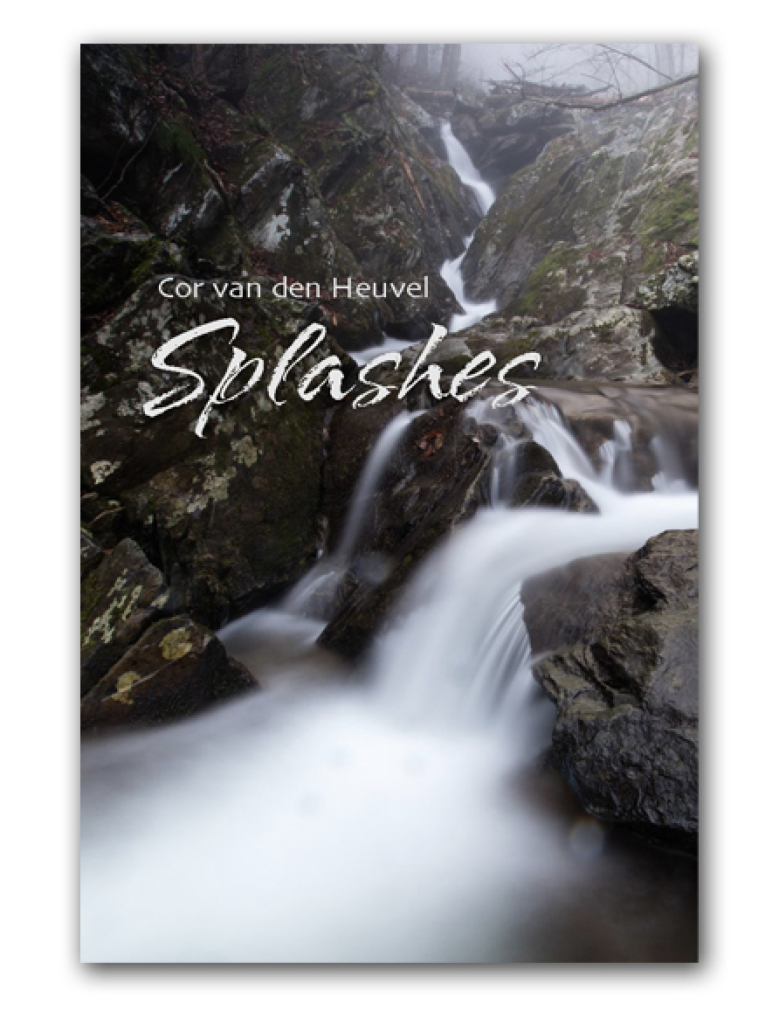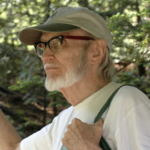
Book Review: Splashes
By Cor van den Heuvel
Published by House of Haiku
Kernersville, North Carolina
2023, Paperback, 108 pages
ISBN: 978-0-9626040-5-8
Ordering Information

Cor van den Heuvel is well known as a pioneer of English-language haiku and as the editor of The Haiku Anthology, the three editions of which have influenced generations of haiku enthusiasts. He was also at the forefront of English-language haibun’s growth in the late 1980s and early ’90s. In this latter area, he’s perhaps best-known for A Boy’s Seasons: Haibun Memoirs, which won a 2011 Merit Book Award from the Haiku Society of America. Splashes offers an additional window onto his work beyond haiku, assembling a miscellany of individual haibun and haiga from the past several decades. It’s a bit of a grab bag, but like all grab bags, it contains a few treasures. Moreover, it provides a glimpse into the mind and practice of one of the genre’s most distinctive voices.
The book is divided into three sections, the first of which comprises 15 written entries drawn from his notebooks. They date from 1972 (Sept. 16, to be precise) to 2006, although the majority are from the1980s. While all contain prose and haiku, most read more as diary entries (e.g., “Later after work about 10 PM ate at Shil-La, the Korean restaurant on Fifth about 30th Street. Had a great meal—hot codfish soup, sushi, five different vegetable appetizers, etc., couple of scotches [Dewars]. Talked to Mrs. Kim, etc.”). While not honed haibun, these notebook entries do offer a glimpse of van den Heuvel’s mind at work—the details on which he focuses, the way he’s trying to capture specific images and sounds—which can be satisfying in its own way. Here’s one entry, from Oct. 26, 1987:
The Pod
The wisteria pod I picked in the Brooklyn Botanical Garden several days ago exploded on my living room table last night with a loud crack. I was in the kitchen. I had placed it under a small “tent” of folded paper so the seeds did not go far—about a foot and still on the table. The pod was now in two lengthwise halves. The noise was as if someone had struck the table with a long, supple stick, or switch, very hard—such as a hazel switch. It made me happy for some reason!
a leaf drifts across the pond alone
The second section consists of seven haiga. All feature van den Heuvel’s handwritten haiku with art that ranges from quick pen-and-ink sketches to what appears to be a watercolor of laundry, sun, and blue sky with the haiku “blue skies / a woman hanging out the wash / waves to a passing train.” This section is more of an interlude, separating the notebook entries and the final section, “Haibun for Basho’s Frog,” which comprises mostly haibun published between 1988 and 2013.
The 11 haibun in this last section range from narratives about specific moments in his life (encountering a milkweed seed while hiking in the Catskills, capturing and creating a home for an injured cricket) to multi-page meditations on such topics as streetlights, city bars, and curbstones. The longest are “The Last Streetlight” (17 pages) and “Stepping Up to the Bar” (16 pages). Both are weighted heavily toward the prose— each contains only 9 haiku, appearing periodically like rest stops on a highway. Given this, they’re a good place to start for insights into van den Heuvel’s writing style.
First, he’s not afraid of description. If current haibun practice emphasizes concision and even “white space” to allow readers to make connections on their own, van den Heuvel at times seems determined to render objects in exacting detail, leaving little to the reader’s imagination. In “The Last Streetlight,” for instance, the first few paragraphs of this haibun talk about the lights with near-schematic descriptions:
A metal rod holds the light to the telephone pole. The rod comes straight out horizontally from the pole, then curves up then down again so that the end fits vertically into the fixture on top of the shade: a small bell-shaped metal housing, really a extension of the shade itself, which contains the socket and wiring.
In “Stepping Up to the Bar,” he applies the same sharp focus:
The top, face, and step of this bar are all of oak. They are stained a dark mahogany color. The raised outside edge of the top, the bar rail, is mahogany. It is rounded with a wave or dip in it. I imagine it has several purposes: to keep glasses and bottles from slipping off the bar, to give patrons extra space to lean an elbow, and to provide a rounded support to grasp with one hand while raising a glass, or gesturing and expostulating. A narrow shelf set down an inch on the bartender’s side of the bar gives him a place to set things down momentarily before placing them on the actual top in front of the thirsty customer.
He’ll leaven out such near-obsessive detail with digressions into the history of an object or even his own history, including memories of his days as a young man hitchhiking across the country. And sometimes he’ll throw in a poetic line that lifts the reader beyond the minute details of the immediate (In “The Last Streetlight,” he notes how after all of the neon of theater marquees and night clubs have been extinguished, “the streetlight took on a soulful, distant wail of a saxophone look, and made your shadow on the sidewalk as you headed home from the just-closed bar seem like the last lost inhabitant of the world”). In the pieces that are less meditative and more narrative, he can apply that same level of detail without the same absorption. The following haibun is, to my mind, an example of van den Heuvel at his most modulated, and his most successful—we again see a streetlight, but in an entirely different context.
Snowstorm
After the long snowfall has silenced the East Village, the streetlights hold the snowy streets in a stillness of softly glowing curves and mounds of snow. Out of everyday objects the snow has created new shapes and landscapes. Garbage cans are white pillars of rounded snow. The cars parked along East Tenth Street have become sloping hills all joined together. The street itself is a still river of white, the snow now too deep for traffic. The building fronts, from steps to eaves, and their iron fences and gates have all been transformed into ornate filigrees of snow. The snow decorates the bare branches of the sidewalk trees so that gingkoes, oaks, and flowering pears are now all snow trees. There is no wind. Only a single person is out walking and now he too is still. The street glows silently in the lamplight.
city street the darkness inside the snow-covered cars
The “city street” haiku is an example of van den Heuvel’s skill at capturing moments that contain layers of meaning and mystery. Throughout the books of his haiku, his almost Hopperesque eye for simple moments that resonate always impresses. That talent is on display here as well. The haiku range from the ethereal
starlight in an empty milkweed pod(from “The Sign”)
to the slightly noir:
waterfront bar the cobblestones glow in the night rain(from “Curbstones”)
Only occasionally do they take on a more prosaic feel, such as this one that follows his memories of being in the “Beat” San Francisco of the 1950s:
long-ago night, Jack Kerouac watches as the film crew lights Joan on foggy Russian Hill(from “Stepping Up to the Bar”)
Or course, since this is a book of haibun, what’s also crucial is how well these haiku resonate with the prose. Generally, most offer some nice interludes (or respites, depending on the length of a narrative) and contribute to the mood and meaning of a piece, as in “Snowstorm.” However, there were a few times when I wished van den Heuvel had allowed the haiku to do more work. Here’s an excerpt from “The Singer,” about his encounter with the song of a bird hidden among the trees of Central Park:
Finally he dropped down from the tree and sailed directly toward where I was standing (I moved about the tree, sometimes standing, sometimes sitting, sometimes lying on the grass) and passed directly over my head, not more than three feet above it. I’m sure he was aware I’d been listening to him. He pulled up on the grass about 15 yards away and began hopping about for worms. He was a robin! His red breast was warmed by the setting sun. He cocked an eye in my direction and then went about getting his supper. When I left he was back in his tree singing away to the gathering shadows.
the stars come out high in the budding tree the robin sings on
The prose ends with a lovely image —and the haiku then repeats the image of the singing robin with its own lovely accompaniment of stars. The prose and the haiku seem to be living side by side rather than being integrated—in a state of companionship rather than marriage.
In such moments I was reminded that Splashes is also largely a historical book. It captures the work of a pioneer over a period when English-language haibun was a work in progress, and writers were exploring how best to adapt the lessons of Japanese masters into a new language and across the centuries. English-language haibun is still, in many ways, a work in progress, but its development has continued in the years since the work in Splashes was written. Titles have gained new attention (see Ray Rasmussen’s “A Title Is a Title Is a Title or Is It?”), the interplay between haiku and prose has been further explored, and writers continue to push the boundaries. However, while styles may evolve, what hasn’t changed is van den Heuvel’s talent for looking at something as commonplace as a streetlamp, a curbstone, or a snowy parked car and turning it into an object of wonder. For that alone, this book should be in the collection of every haibun enthusiast.
About the Reviewer

Rich Youmans lives on Cape Cod with his wife, Alice. His books include All the Windows Lit (Snapshot Press, 2017) and Head-On (Red Bird Chapbooks, 2018). He is also the co-author, with Roberta Beary and Lew Watts, of Haibun: A Writer’s Guide (Ad Hoc Fiction, 2023).
